This site uses cookies as defined in our Cookie Policy, by continuing to use this site you agree to their use.
Continue
| Arrive | Depart | ||||||
| 5th05 | MayMay | 202626 | Valletta, Malta, embark on the Emerald Sakara | ||||
Malta's capital, the minicity of Valletta, has ornate palaces and museums protected by massive fortifications of honey-color limestone. Houses along the narrow streets have overhanging wooden balconies for people-watching from indoors. Generations ago they gave housebound women a window on the world of the street. The main entrance to town is through the City Gate (where all bus routes end), which leads onto Triq Repubblika (Republic Street), the spine of the grid-pattern city and the main shopping street. Triq Mercante (Merchant Street) parallels Repubblika to the east and is also good for strolling. From these two streets, cross streets descend toward the water; some are stepped. Valletta's compactness makes it ideal to explore on foot. City Gate and the upper part of Valletta are experiencing vast redevelopment that includes a new Parliament Building and open-air performance venue. The complex, completed mid-2013, has numerous pedestrian detours in place along with building noise and dust. Before setting out along Republic Street, stop at the tourist information office on Merchant Street for maps and brochures. Your cruise begins in Malta and Valletta, where you’ll be transferred to your Emerald Cruises luxury yacht to commence your memorable voyage, sailing through the glorious Mediterranean Sea. Valletta, the tiny capital of Malta and UNESCO World Heritage Centre, is a living testament to the Baroque period, with well-preserved buildings, ornate churches, and magnificent fortifications. Please book your flight to arrive into Valletta prior to 07:00 PM. Docked: Overnight | |||||||
| 6th06 | MayMay | 202626 | Valletta, Malta | ||||
Malta's capital, the minicity of Valletta, has ornate palaces and museums protected by massive fortifications of honey-color limestone. Houses along the narrow streets have overhanging wooden balconies for people-watching from indoors. Generations ago they gave housebound women a window on the world of the street. The main entrance to town is through the City Gate (where all bus routes end), which leads onto Triq Repubblika (Republic Street), the spine of the grid-pattern city and the main shopping street. Triq Mercante (Merchant Street) parallels Repubblika to the east and is also good for strolling. From these two streets, cross streets descend toward the water; some are stepped. Valletta's compactness makes it ideal to explore on foot. City Gate and the upper part of Valletta are experiencing vast redevelopment that includes a new Parliament Building and open-air performance venue. The complex, completed mid-2013, has numerous pedestrian detours in place along with building noise and dust. Before setting out along Republic Street, stop at the tourist information office on Merchant Street for maps and brochures. This stunning fortified city is strategically positioned on a hilly peninsula, offering breathtaking views of the Mediterranean Sea. As well as storied history, Valletta is the host of lively markets and festivals. Included Excursion DiscoverMORE Docked: Overnight - 18:00 | |||||||
| 7th07 | MayMay | 202626 | Giardini Naxos, Italy | ||||
Set on Sicily’s eastern shores, the picturesque town of Giardini Naxos offers stunning views of the Ionian Sea and Mount Etna – the fabled active volcano. This seaside town is known for its beautiful sandy beaches, clear blue waters, and vibrant waterfront promenade edged with bustling restaurants, shops, and cafés. Giardini Naxos also harbours a rich history, with archaeological sites dating back to ancient times. DiscoverMORE DiscoverMORE Offshore: 08:00 - 21:00 | |||||||
| 8th08 | MayMay | 202626 | Lipari, Italy | ||||
The largest and most developed of the Aeolians, Lipari welcomes you with distinctive pastel-color houses. Fields of spiky agaves dot the northernmost tip of the island, Acquacalda, indented with pumice and obsidian quarries. In the west is San Calogero, where you can explore hot springs and mud baths. From the red-lava base of the island rises a plateau crowned with a 16th-century castle and a 17th-century cathedral. Lipari is the largest and most populated of the Aeolian Islands, a volcanic archipelago off the coast of Sicily amid the shimmering Tyrrhenian Sea. Its stunning scenery is defined by its rugged coastline, beautiful beaches lapped by crystal-clear turquoise waters and lush vegetation. The island also boasts a charming old town with narrow streets and traditional houses painted in pastel hues, as well as a 16th-century castle, which reveals panoramic views of the surrounding area. DiscoverMORE DiscoverMORE Offshore: 08:00 - 18:00 | |||||||
| 9th09 | MayMay | 202626 | Amalfi, Italy | ||||
At first glance, it's hard to imagine that this resort destination was one of the world's great naval powers, and a sturdy rival of Genoa and Pisa for control of the Mediterranean in the 11th and 12th centuries. Once the seat of the Amalfi Maritime Republic, the town is set in a verdant valley of the Lattari Mountains, with cream-colored and pastel-hued buildings tightly packing a gorge on the Bay of Salerno. The harbor, which once launched the greatest fleet in Italy, now bobs with ferries and blue-and-white fishing boats. The main street, lined with shops and pasticcerie, has replaced a raging mountain torrent, and terraced hills flaunt the green and gold of lemon groves. Bearing testimony to its great trade with Tunis, Tripoli, and Algiers, Amalfi remains honeycombed with Arab-Sicilian cloisters and covered passages. In a way Amalfi has become great again, showing off its medieval glory days with sea pageants, convents-turned-hotels, ancient paper mills, covered streets, and its glimmering cathedral. Amalfi is a charming coastal town, perched on the cliffs of the Amalfi Coast, overlooking the azure waters of the Tyrrhenian Sea. Amalfi is known for its stunning views, picturesque streets, and rich history. The town is famous for its beautiful cathedral, the Duomo di Amalfi, which dates to the 9th century and features intricate Byzantine mosaics. Explore the historic centre of Amalfi, with its narrow alleys, colourful buildings, and quaint shops selling local ceramics. DiscoverMORE Offshore: 12:00 - 18:00 | |||||||
| 10th10 | MayMay | 202626 | Capri, Italy | ||||
Tour description Capri, Italy Popular since Roman times when the emperors built their villas on Capri, this island is surely one of the world's most famous and beautiful spots. Visiting Capri, it is easy to see why the ancient Romans fell in love with this place 2,000 years ago - the craggy mountains, the sea caves and grottos and the brilliantly colored flowers cast a magic spell then and still capture the admiration of today's travelers. There are sleek yachts moored in the deep blue waters of the bays, and beautiful villas and tiny villages cling to steep slopes. An excellent year-round climate and a breathtaking landscape complete the picture of a storybook island. There are two main villages - Capri Town, site of the popular meeting point "Piazzetta," and Anacapri, the upper town, dominated by 1,750-foot-high Monte Solaro, the highest point on the island. Both remain the "in" scene for international travelers. By spending millions on comfort and style, the island has ensured its continuing success. After a trip to upper-level Anacapri, visitors enjoy strolling the narrow, cobbled streets of Capri Town, browsing in chic boutiques and spending time in the Piazzetta with a drink in one of the outdoor cafés. There is a funicular from the main port of Marina Grande to Capri Town; from Anacapri, a chair lift whisks visitors to the top of Monte Solaro for a spellbinding view. The magical Blue Grotto can be reached by boat from Marina Grande, but entrance into the grotto depends for the most part on sea conditions. Please Note: For your convenience, the shore excursions offered for this port of call are available to reserve in advance at www.silversea.com until August 8 , as well as offered for purchase on board, unless otherwise noted in the description. Going Ashore in Capri Pier Information The ship is scheduled to anchor off Capri's main port, Marina Grande. Guests will be taken ashore via local tenders, arriving at the pier just a short distance from the funicular to Capri Town. Taxis and minibuses are also available near the pier area. Be sure to agree on the fare before starting out. Shopping Capri is a shopping mecca, though by no means inexpensive. Upscale shops and boutiques offer an array of jewelry, designer fashions, resort wear, straw articles and souvenir items. Start from the Piazzetta and the streets fanning out from the square. Some shops may be closed between 12:30/1:00 p.m. and 4:00/4:30 p.m. The local currency is the euro. Cuisine Capri features plenty of open-air eateries in addition to top rated restaurants. Fresh seafood and delicious pasta dishes make for a nice lunch; for a quick meal there are tempting sandwiches and pizza. You might enjoy a hearty Italian table wine with lunch. Other Sights Capri Town La Piazzetta is the main square of Capri Town located just opposite the upper funicular station. The square is an ideal place from where to start exploring or shopping. Sidewalk cafés around the square provide residents and visitors with a popular pastime - people-watching while sipping a drink or enjoying a coffee. Anacapri Reaching Capri's second town is via local minibus. In addition to numerous souvenir shops and designer boutiques, attractions include Axel Munthe's Villa San Michele and the chair lift to Monte Solaro. Blue Grotto Boat excursions to the Blue Grotto can be booked locally at Marina Grande. Be aware that it is necessary to transfer into smaller boats in front of the grotto. Also, entrance to the grotto is subject to weather and sea conditions. For this reason, tours to the Blue Grotto are frequently cancelled. Private arrangements are not available in this port. A legendary island set in Italy’s Bay of Naples, Capri is synonymous with stunning natural beauty. Turquoise waters and beautiful coves dot the dramatic, rugged coastline, and high-end hotels, luxury shopping outlets and gastronomic fine-dining attract the rich and famous – who dock their yachts in the island’s stunning Marina Grande. DiscoverMORE DiscoverMORE Offshore: 09:00 - 07:00 (next day) | |||||||
| 11th11 | MayMay | 202626 | Sorrento, Italy | ||||
Sorrento may have become a jumping-off point for visitors to Pompeii, Capri, and Amalfi, but you can find countless reasons to love it for itself. The Sorrentine people are fair-minded and hardworking, bubbling with life and warmth. The tuff cliff on which the town rests is spread over the bay, absorbing sunlight, while orange and lemon trees waft their perfume in spring. Winding along a cliff above a small beach and two harbors, the town is split in two by a narrow ravine formed by a former mountain stream. To the east, dozens of hotels line busy Via Correale along the cliff—many have "grand" included in their names, and some indeed still are. To the west, however, is the historic sector, which still enchants. It's a relatively flat area, with winding, stone-paved lanes bordered by balconied buildings, some joined by medieval stone arches. The central piazza is named after the poet Torquato Tasso, born here in 1544. This part of town is a delightful place to walk through. Craftspeople are often at work in their stalls and shops and are happy to let you watch; in fact, that's the point. Music spots and bars cluster in the side streets near Piazza Tasso. Another gem to discover on the stunning Amalfi Coast, Sorrento is a much-loved resort town best known for its breathtaking views of the Bay of Naples and imposing Mount Vesuvius across the water. Sorrento is also a popular destination for those seeking a mix of breathtaking scenery, delicious cuisine, and ancient sites. The town's historic centre is filled with atmospheric narrow streets, lined with shops selling traditional products, such as ceramics and limoncello, made from locally grown lemons. DiscoverMORE EmeraldPLUS Offshore: 08:00 - 22:00 | |||||||
| 12th12 | MayMay | 202626 | Gaeta, Italy | ||||
Gaeta is a charming coastal town nestled amid the Italian Lazio region and between the grand cities of Rome and Naples. Offering stunning views of the Tyrrhenian Sea, Gaeta is renowned for its beautiful beaches and crystal-clear turquoise waters. The town however is also rich in history, with ancient Roman ruins and medieval churches scattered throughout its picturesque streets. Gaeta is also famed for its seafood, with many restaurants serving fresh fish caught daily by local fishermen and its distinctive olives and olive oil, which are sold in markets and shops throughout the area. DiscoverMORE Docked: 08:00 - 15:00 | |||||||
| 13th13 | MayMay | 202626 | Porto Ercole, Italy | ||||
Within Italy’s romantic Tuscany region, you’ll find Porto Ercole a laid-back harbour town with a picturesque bay dotted with luxury yachts and bobbing fishing boats. This stunning historic town is worth exploring for its maze of narrow laneways, stone houses and several important landmarks, including old fortresses, Forte Filippo, Forte Stella, and La Rocca – built during Spanish domination in the 16th century. Today choose between our Included Excursion or EmeraldACTIVE option. Included Excursion EmeraldACTIVE Offshore: 08:00 - 21:00 | |||||||
| 14th14 | MayMay | 202626 | Civitavecchia, Italy | ||||
Italy's vibrant capital lives in the present, but no other city on earth evokes its past so powerfully. For over 2,500 years, emperors, popes, artists, and common citizens have left their mark here. Archaeological remains from ancient Rome, art-stuffed churches, and the treasures of Vatican City vie for your attention, but Rome is also a wonderful place to practice the Italian-perfected il dolce far niente, the sweet art of idleness. Your most memorable experiences may include sitting at a caffè in the Campo de' Fiori or strolling in a beguiling piazza. After breakfast, set off to explore Rome and uncover the ancient history of this storied city. In the afternoon, we’ll welcome you back on board your Emerald Cruises luxury yacht for the second half of your journey to explore the Mediterranean. *Please verify with the Shore Excursion Manager onboard whether a DiscoverMORE tour is available. Docked: 06:00 - 18:00 | |||||||
| 15th15 | MayMay | 202626 | Calvi, Corsica, France | ||||
Calvi, Corsica's slice of the Riviera, has been described by author Dorothy Carrington as "an oasis of pleasure on an otherwise austere island." Calvi prospered by supplying products to Genoa; its citizens remained loyal supporters of Genoa long after the rest of the island declared independence. Calvi also claims to be the birthplace of Christopher Columbus. During the 18th century the town endured assaults from Corsican nationalists, including celebrated patriot Pasquale Paoli. Today Calvi sees a summertime invasion of tourists, drawn to the 6-km (4-mile) stretch of sandy white beach, impressive citadel overlooking the Old Town, lively restaurants, and buzzing nightlife. According to local legend, Calvi, set on the beautiful island of Corsica, is where the intrepid, 15th century explorer, Christopher Columbus, was born. While historians may debate this, the natural beauty and rich culture of Calvi is undisputed. Calvi's beach presents a crescent-shaped bay of powdery white sand fringed by maritime pines, while the town has evolved as Corsica’s ‘culture capital’, hosting several music festivals over the idyllic summer months. | |||||||
| 16th16 | MayMay | 202626 | Livorno, Italy | ||||
Livorno is a gritty city with a long and interesting history. In the early Middle Ages it alternately belonged to Pisa and Genoa. In 1421 Florence, seeking access to the sea, bought it. Cosimo I (1519–74) started construction of the harbor in 1571, putting Livorno on the map. After Ferdinando I de' Medici (1549–1609) proclaimed Livorno a free city, it became a haven for people suffering from religious persecution; Roman Catholics from England and Jews and Moors from Spain and Portugal, among others, settled here. The Quattro Mori (Four Moors), also known as the Monument to Ferdinando I, commemorates this. (The statue of Ferdinando I dates from 1595, the bronze Moors by Pietro Tacca from the 1620s.)In the following centuries, and particularly in the 18th, Livorno boomed as a port. In the 19th century the town drew a host of famous Britons passing through on their grand tours. Its prominence continued up to World War II, when it was heavily bombed. Much of the town's architecture, therefore, postdates the war, and it's somewhat difficult to imagine what it might have looked like before. Livorno has recovered from the war, however, as it's become a huge point of departure for container ships, as well as the only spot in Tuscany for cruise ships to dock for the day.Most of Livorno's artistic treasures date from the 17th century and aren't all that interesting unless you dote on obscure baroque artists. Livorno's most famous native artist, Amedeo Modigliani (1884–1920), was of much more recent vintage. Sadly, there's no notable work by him in his hometown.There may not be much in the way of art, but it's still worth strolling around the city. The Mercato Nuovo, which has been around since 1894, sells all sorts of fruits, vegetables, grains, meat, and fish. Outdoor markets nearby are also chock-full of local color. The presence of Camp Darby, an American military base just outside town, accounts for the availability of many American products.If you have time, Livorno is worth a stop for lunch or dinner at the very least. Along the western coast of Tuscany, the bustling city of Livorno boasts a modern seaport, but is best known for its scenic beauty, picturesque views of the azure Mediterranean Sea and delicious fresh seafood. The city's culinary scene is not surprisingly, heavily influenced by its seaside location, tempting with signature dishes such as 'cacciucco', a traditional fish stew that is a must-try for every visitor. | |||||||
| 17th17 | MayMay | 202626 | Carrara, Italy | ||||
Further along the Tuscan coast, you’ll arrive in Marina di Carrara. This lovely seaside village is famed for the premium, pale Italian marble that is mined and quarried from the nearby mountains and used to create some of the world’s most important artistic wonders, such as the iconic, Michelangelo’s David. These shimmering mountains of purest marble contrast beautifully with Marina di Carrara’s coastal scenery. | |||||||
| 18th18 | MayMay | 202626 | Portovenere, Italy | ||||
The colorful facades and pedestrians-only calata (promenade) make Portovenere the quintessential Ligurian seaside village. As a UNESCO World Heritage Site, its harbor is lined with tall, thin "terratetto" houses that date from as far back as the 11th century and are connected in a wall-like formation to protect against attacks by the Pisans and local pirates. Its tiny, carruggi (alley-like passageways) lead to an array of charming shops, homes, and gardens and eventually to the village's impressive Castle Doria high on the olive tree covered hill. To the west standing guard over the Mediterranean is the picturesque medieval Chiesa di San Pietro, once the site of a temple to Venus (Venere in Italian), from which Portovenere gets its name. Nearby, in a rocky area leading to the sea, is Byron's Cave, a favorite spot that the poet loved to swim out into the sea from. We set sail early in the morning for the Italian Ligurian coast and Porto Venere. This ancient town and UNESCO World Heritage Site harbours a romantic history, thanks to its penchant for attracting famous poets and artists over the centuries. The wonderful swimming spots here were beloved, amongst others, by the legendary poet, Lord Byron, who regularly swam and meditated here in the early 1800s. One of Porto Venere's most striking features is its gothic-style Church of St. Peter, perched atop a rocky headland overlooking the sparkling sea. | |||||||
| 19th19 | MayMay | 202626 | Santa Margherita Ligure, Italy | ||||
Welcome to Santa Margherita Ligure, an Italian resort town presenting panoramic views and revered for its timeless elegance and style. For those seeking ‘La dolce vita’, you’ll find it here in abundance. Stroll the Santa Margherita promenade, or the pebbly beachfront, admiring the gleaming yachts and sailing boats. Explore a beautiful Baroque church or sample freshly caught, succulent red shrimps. Later in the morning, you’ll sail on to Portofino. Nestled along the Italian Riviera, Portofino boasts a rich gastronomic scene, a picturesque harbour and narrow streets lined with charming pastel-hued houses, high-end boutiques and seafood restaurants. | |||||||
| 19th19 | MayMay | 202626 | Portofino, Italy | ||||
One of the most photographed villages along the coast, with a decidedly romantic and affluent aura, Portofino has long been a popular destination for the rich and famous. Once an ancient Roman colony and taken by the Republic of Genoa in 1229, it’s also been ruled by the French, English, Spanish, and Austrians, as well as by marauding bands of 16th-century pirates. Elite British tourists first flocked to the lush harbor in the mid-1800s. Some of Europe's wealthiest drop anchor in Portofino in summer, but they stay out of sight by day, appearing in the evening after buses and boats have carried off the day-trippers.There's not actually much to do in Portofino other than stroll around the wee harbor, see the castle, walk to Punta del Capo, browse at the pricey boutiques, and sip a coffee while people-watching. However, weaving through picture-perfect cliffside gardens and gazing at yachts framed by the sapphire Ligurian Sea and the cliffs of Santa Margherita can make for quite a relaxing afternoon. There are also several tame, photo-friendly hikes into the hills to nearby villages.Unless you're traveling on a deluxe budget, you may want to stay in Camogli or Santa Margherita Ligure rather than at one of Portofino's few very expensive hotels. Restaurants and cafés are good but also pricey (don't expect to have a beer here for much under €10). | |||||||
| 20th20 | MayMay | 202626 | Monte-Carlo, Monaco | ||||
On one of the best stretches of the Mediterranean, this classic luxury destination is one of the most sought-after addresses in the world. With all the high-rise towers you have to look hard to find the Belle Époque grace of yesteryear. But if you head to the town's great 1864 landmark Hôtel de Paris—still a veritable crossroads of the buffed and befurred Euro-gentry—or enjoy a grand bouffe at its famous Louis XV restaurant, or attend the opera, or visit the ballrooms of the casino, you may still be able to conjure up Monaco's elegant past. Prince Albert II, a political science graduate from Amherst College, traces his ancestry to Otto Canella, who was born in 1070. The Grimaldi dynasty began with Otto's great-great-great-grandson, Francesco Grimaldi, also known as Frank the Rogue. Expelled from Genoa, Frank and his cronies disguised themselves as monks and in 1297 seized the fortified medieval town known today as Le Rocher (the Rock). Except for a short break under Napoléon, the Grimaldis have been here ever since, which makes them the oldest reigning family in Europe. In the 1850s a Grimaldi named Charles III made a decision that turned the Rock into a giant blue chip. Needing revenue but not wanting to impose additional taxes on his subjects, he contracted with a company to open a gambling facility. The first spin of the roulette wheel was on December 14, 1856. There was no easy way to reach Monaco then—no carriage roads or railroads—so no one came. Between March 15 and March 20, 1857, one person entered the casino—and won two francs. In 1868, however, the railroad reached Monaco, and it was filled with Englishmen who came to escape the London fog. The effects were immediate. Profits were so great that Charles eventually abolished all direct taxes. Almost overnight, a threadbare principality became an elegant watering hole for European society. Dukes (and their mistresses) and duchesses (and their gigolos) danced and dined their way through a world of spinning roulette wheels and bubbling champagne—preening themselves for nights at the opera, where such artists as Vaslav Nijinsky, Sarah Bernhardt, and Enrico Caruso came to perform. Along with the tax system, its sensational position on a broad, steep peninsula that bulges into the Mediterranean—its harbor sparkling with luxury cruisers, its posh mansions angling awnings toward the nearly perpetual sun—continues to draw the rich and famous. One of the latest French celebrities to declare himself "Monégasque," thus giving up his French passport, is superchef Alain Ducasse, who said that he made the choice out of affection for Monaco rather than tax reasons. Pleasure boats vie with luxury cruisers in their brash beauty and Titanic scale, and teams of handsome young men—themselves dyed blond and tanned to match—scour and polish every gleaming surface. As you might expect, all this glitz doesn't come cheap. Eating is expensive, and even the most modest hotels cost more here than in nearby Nice or Menton. As for taxis, they don't even have meters so you are completely at the driver's mercy (with prices skyrocketing during events such as the Grand Prix). For the frugal, Monaco is the ultimate day-trip, although parking is as coveted as a room with a view. At the very least you can afford a coffee at Starbucks. The harbor district, known as La Condamine, connects the new quarter, officially known as Monte Carlo with Monaco-Ville (or Le Rocher), a medieval town on the Rock, topped by the palace, the cathedral, and the Oceanography Museum. Have no fear that you'll need to climb countless steps to get to Monaco-Ville, as there are plenty of elevators and escalators climbing the steep cliffs. But shuttling between the lovely casino grounds of Monte Carlo and Old Monaco, separated by a vast port, is a daunting proposition for ordinary mortals without wings, so hop on the No. 1 bus from Saint Roman, or No. 2 from the Jardin Exotique - Both stop at Place du Casino and come up to Monaco Ville. Officially known as the Principality of Monaco, the sovereign city-state of Monaco is renowned worldwide for its opulence and glamour, boasting high-end casinos, a yacht-lined harbour, the prestigious Grand Prix motor racing event and exclusive Monte Carlo quarter. This gem of the Côte d'Azur is also home to Monaco’s royal household, several museums and numerous cultural events hosted throughout the year, celebrating anything from music and dance to theatre and the visual arts. | |||||||
| 21st21 | MayMay | 202626 | Nice, France, disembark the Emerald Sakara | ||||
United with France only since 1860, Nice has its own history and atmosphere, which dates back 230,000 years. It was on Colline du Château (now château-less) and at the Plage des Ponchettes, in front of the Old Town, that the Greeks established a market-port in 350 BC and named it Nikaia, which would become Marseilles' chief coastal rival. The Romans established themselves a little later on the hills of Cimiez (Cemenelum), already previously occupied by Ligurians and Celts, and quickly overshadowed the waterfront port. After falling to the Saracen invasions, Nice regained power as an independent state, becoming an important port in the early Middle Ages.So cocksure did it become that in 1388, Nice, along with the hill towns behind, effectively seceded from the county of Provence, under Louis d'Anjou, and allied itself with Savoie. Thus began its liaison with the House of Savoy, and through it with Piedmont and Sardinia, it was the Comté de Nice (Nice County). This relationship lasted some 500 years, tinting the culture, architecture, and dialect in rich Italian hues.By the 19th century Nice was flourishing commercially, locked in rivalry with the neighboring shipping port of Genoa. Another source of income: the dawning of tourism, as first the English, then the Russian nobility, discovered its extraordinary climate and superb waterfront position. A parade of fine stone mansions and hotels closed into a nearly solid wall of masonry, separated from the smooth-round rocks of the beach by what was originally named Camin deis Anglés (the English Way), which of course is now the famous Promenade des Anglais. This magnificent crescent, which is seeking UNESCO recognition, is one of the noblest in France. Many of Nice's most delightful attractions—the Cours Saleya market, the Old Town streets, the Hotel Negresco, and the Palais Masséna—are on or close to this 10-km (6-mile) waterfront, making it the first stop for most visitors, while the redevelopment of Nice's port, around the other side of the Colline du Château, makes it easier for amblers who want to take in the Genoese architecture or peruse the antiques at the Puces de Nice, now part of the Promenade des 100 Antiquaires, along Quai Papacino. Nice also has the distinction of the "Family Plus" label, with free strollers, play areas, and restaurants with child-friendly activities. Your unforgettable yacht cruise concludes in the coastal city of Nice, where you’ll be transferred to the airport for your return flight home or to continue your holiday. Please book your flight to depart out of Nice after 12:00 PM. The itinerary is a guide only and may be amended for operational reasons. As such Emerald Cruises cannot guarantee the cruise will operated unaltered from the itinerary states above. Please refer to our terms and conditions for further information. | |||||||

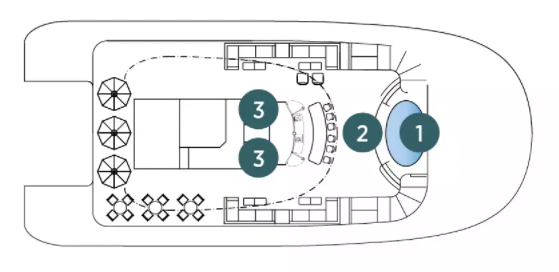





The images shown are for illustration purposes only and may not be an exact representation of what you find on the ship.
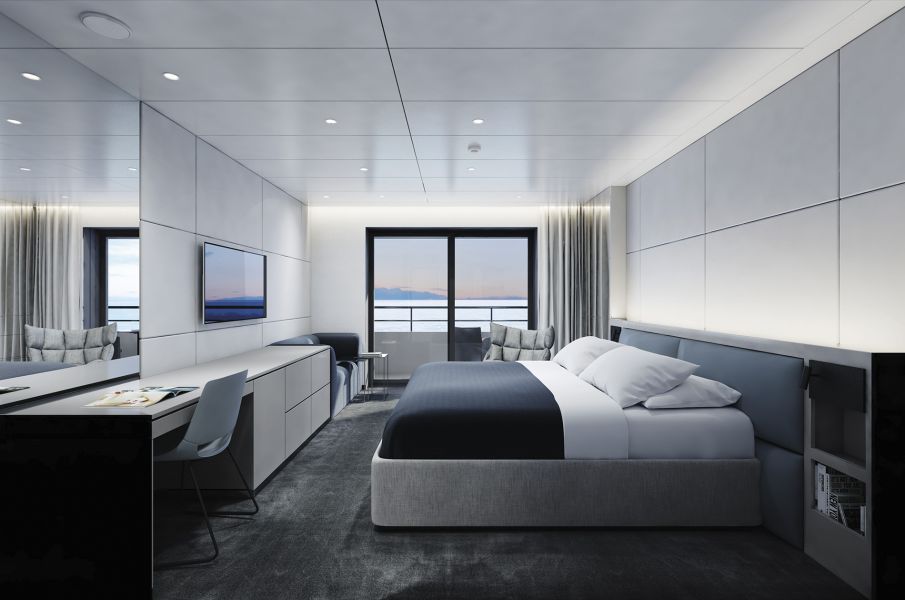
Divided between the Observation and Panorama decks, our Balcony Suites are your stylish home-away-from-home.
Featuring everything you’d expect from a world-class hotel, each one includes your own private balcony, from which to enjoy the stunning panoramas.
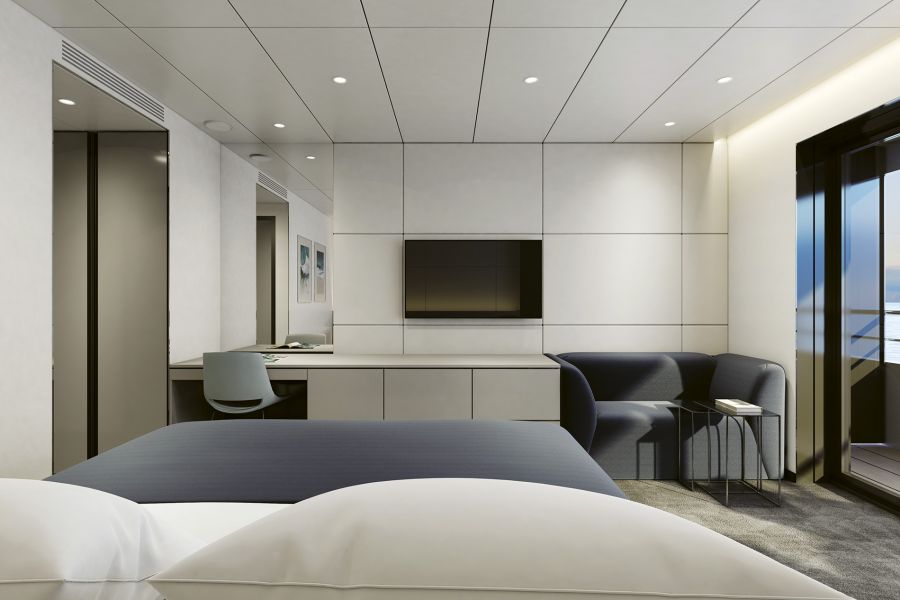
Situated on the Pool Deck, our two Deluxe Balcony Suites boast more space for your comfort.
Along with a private balcony, additional inclusions consist of coffee and tea-making facilities and a pillow menu for the perfect night’s sleep.

You’ll find six of our superb value Oceanview Staterooms on the Emerald Deck, situated towards the front of the yacht, each with their own ocean-view window.
Instantly settle in with our selection of included modern amenities and make the most of your close proximity to the Horizon Bar & Lounge.
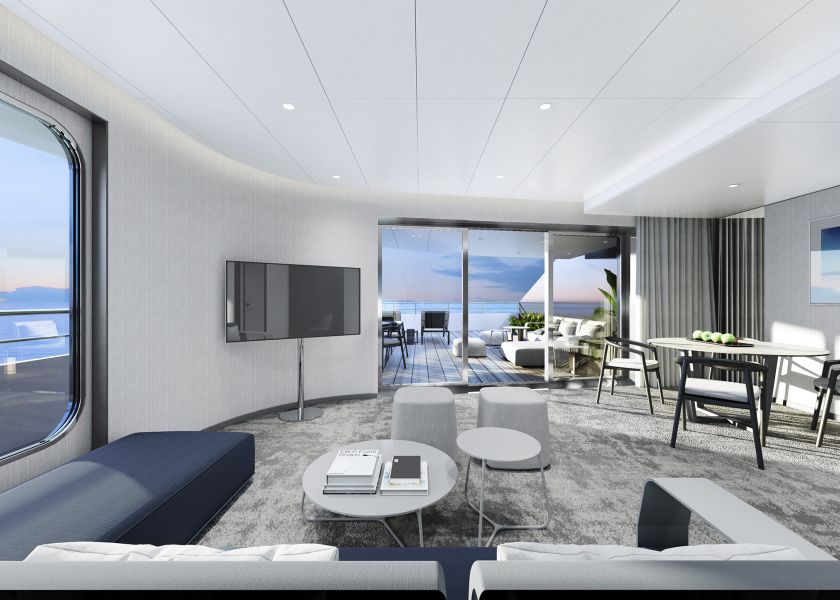
You’ll find our largest and most prestigious suites at the front of the Pool Deck, promising truly exceptional views of the unfolding landscapes.
A separate bedroom and lounge area gives you more room to roam, while a walk-in wardrobe and large private terrace encourage you to really settle into your boutique Owner's Suite.
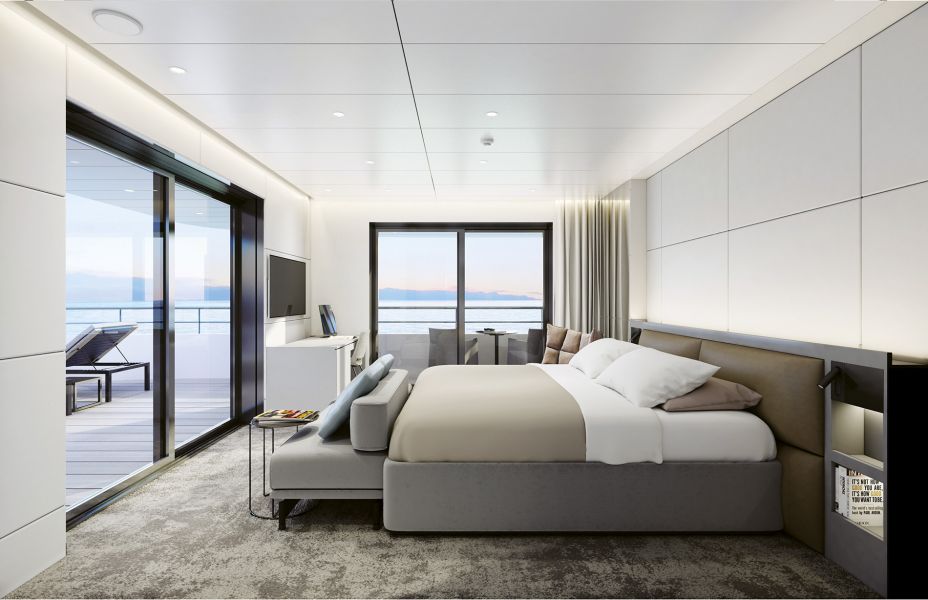
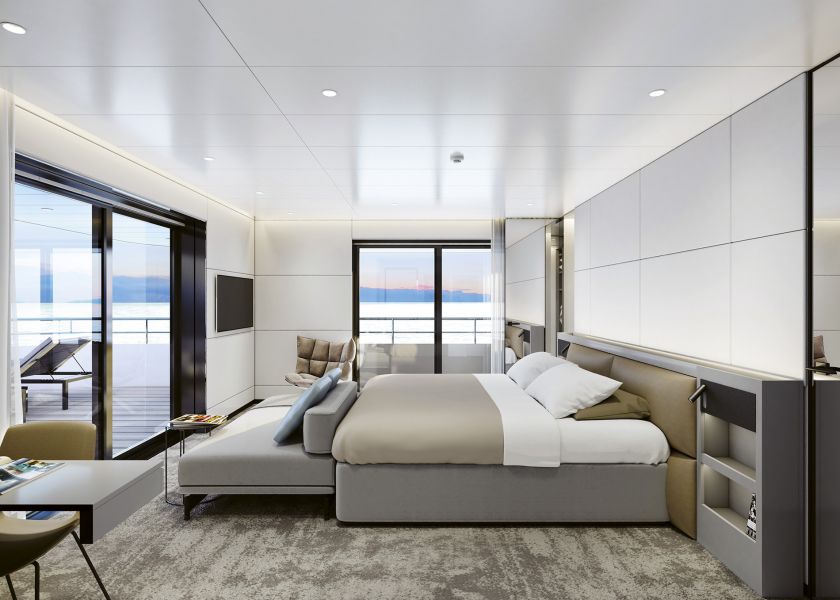
Wonderfully positioned at the back of the Observation Deck, you’ll be treated to sensational ocean and coastal views from your large private terrace.
Toast to your arrival with a complimentary bottle of champagne and a decadent fruit platter which will be waiting for you.
The images shown are for illustration purposes only and may not be an exact representation of what you find on the ship.
The images shown are for illustration purposes only and may not be an exact representation of what you find on the ship.
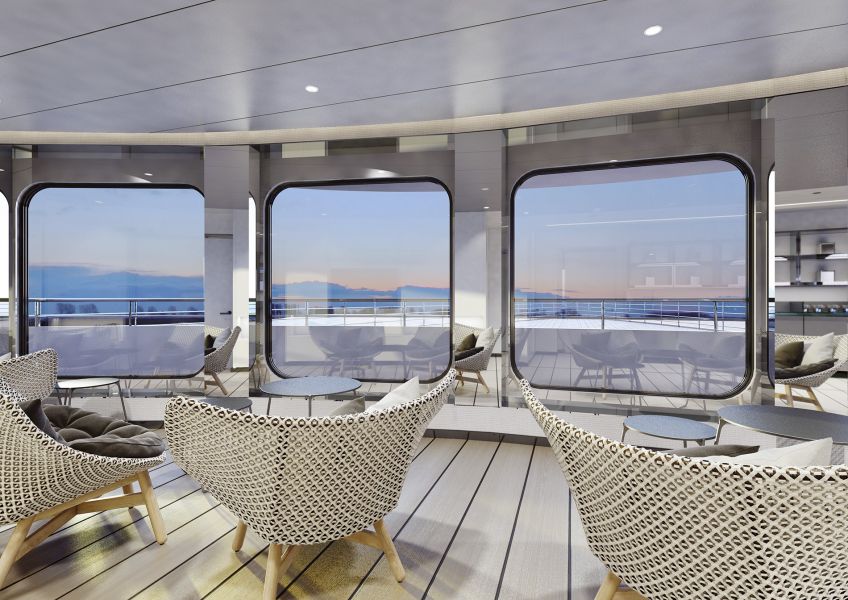
Head to the Observation Deck area for spectacular views or a morning yoga session. In the Observation Lounge, sit back and relax with a good book or play a game of chess.
The images shown are for illustration purposes only and may not be an exact representation of what you find on the ship.
The images shown are for illustration purposes only and may not be an exact representation of what you find on the ship.
| Return flights including luggage allowance | |||
| Overseas Transfers | |||
| 16 nights aboard the Emerald Sakara | |||
| Return airport transfers | |||
| Wine, beer & soft drinks with lunch & dinner | |||
| Gratuities Included | |||
| One complimentary shore excursion in every port | |||
| Bikes for passenger use | |||
| Free Wi-Fi included | |||
| Port Taxes and Fees | |||
 | ABTA and ATOL Protection* | ||
Fly/cruise package |
Date 5th May 2026 |
Nts 16 |
Interior  |
Oceanview  |
Balcony  |
Suite £14,332pp |
Interior  |
Oceanview  |
Balcony  |
Suite £28,664pp |
Date 5th May 2026 |
Nts 16 |
Interior  |
Oceanview  |
Balcony  |
Suite £14,332pp |
Interior  |
Oceanview  |
Balcony  |
Suite £28,664pp |






Fusion Cruises when selling travel arrangements is a trading name of The Midcounties Co-operative Ltd. Fusion Cruises is an Accredited Body Member of Midcounties Co-operative Travel Consortium. (ABTA:P6652, ATOL:6053).
Book with Confidence. We are a Member of ABTA which means you have the benefit of ABTA’s assistance and Code of Conduct.
Some of the flights and flight-inclusive holidays on this website are financially protected by the ATOL scheme but ATOL protection does not apply to all holiday and travel services offered on this website. This website will provide you with information on the protection that applies in the case of each holiday and travel service offered before you make your booking. If you do not receive an ATOL Certificate then the booking will not be ATOL protected. If you do receive an ATOL Certificate but all parts of your trip are not listed on it, those parts will not be ATOL protected. Please see our booking conditions for information, or for more information about financial protection and the ATOL Certificate go to: www.caa.co.uk
